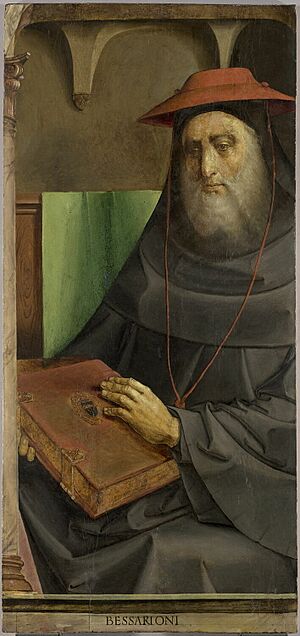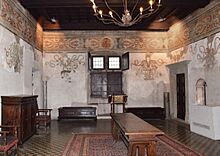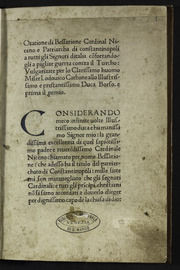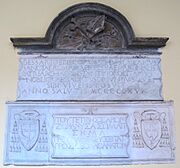Bessarion facts for kids
Quick facts for kids Bessarion |
|
|---|---|
| 'Cardinal Latin Patriarch of Constantinople' |
|

Painting c. 1476 by Justus van Gent and Pedro Berruguete
|
|
| Diocese | Constantinople |
| Predecessor | Isidore of Kiev |
| Successor | Pietro Riario |
| Orders | |
| Rank | Cardinal bishop |
| Personal details | |
| Birth name | Basileios |
| Born | 2 January 1403 Trebizond, Empire of Trebizond |
| Died | 18 November 1472 Ravenna, Papal States |
| Nationality | Greek |
| Denomination | Catholic (formerly Eastern Orthodox)
Philosophy career |
| Era | Renaissance philosophy |
| Region | Western philosophy |
| School | Neoplatonism |
|
Main interests
|
Metaphysics, theology |
|
Influences
|
|
|
Influenced
|
|
| Coat of arms | |
| Styles of Bessarion |
|
|---|---|
 |
|
| Reference style | His Eminence |
| Spoken style | Your Eminence |
| Informal style | Cardinal |
| See | Constantinople |
Bessarion (Greek: Βησσαρίων; born January 2, 1403 – died November 18, 1472) was a very important Greek scholar. He lived during the Renaissance and was a Catholic cardinal. He helped bring back interest in Greek learning in the 1400s.
Bessarion studied Neoplatonic philosophy with a famous teacher named Gemistus Pletho. Later, he became the Latin Patriarch of Constantinople. He was even considered for the job of Pope twice!
His original name was Basil (Greek: Βασίλειος, Basileios). He took the name Bessarion when he became a monk. Sometimes people mistakenly call him Johannes Bessarion.
Contents
Who was Cardinal Bessarion?
Bessarion was born in Trebizond. This city was a busy port on the Black Sea in what is now Turkey. It was a center for Greek culture for a long time. He was born around 1403.
Bessarion's Love for Neoplatonism
Bessarion went to school in Constantinople. In 1423, he traveled to Mystras, Peloponnese, to study Neoplatonism with Gemistus Pletho. This philosophy mixed ideas from Plato with other spiritual thoughts.
Under Pletho, Bessarion learned many subjects. These included math, astronomy, and geography. He also studied how philosophy connected to the physical world and the universe. Neoplatonism also involved ideas about numbers and their link to spiritual forms.
Bessarion kept his Neoplatonic beliefs throughout his life. Even as a cardinal, he used ideas and words from this philosophy. It was unusual for someone with these views to be so important in the Catholic Church. However, some Catholic scholars later criticized his ideas.
Bessarion's Role in Church Unity
Bessarion became a monk and took the name Bessarion. In 1436, he became the head of a monastery in Constantinople. A year later, the Byzantine Emperor John VIII Palaeologus made him the metropolitan of Nicaea.
The emperor took Bessarion to Italy in 1437. Their goal was to unite the Eastern (Orthodox) and Western (Catholic) churches. The emperor hoped that if the churches reunited, Western Europe would help fight the Ottoman Empire.
Bessarion was a key person in the Byzantine group at the Council of Ferrara-Florence. This was a big meeting to discuss church unity. On July 6, 1439, he read the declaration of the Greek churches. This happened in Florence, with Pope Eugene IV and Emperor John VIII Palaeologus present.
Some historians have wondered if Bessarion truly believed in the union. But many believe he was sincere. He wrote that he would not have supported the union if he thought the Latin church was wrong.
When he returned home, many people were angry with him. They did not like his support for uniting the churches. But Pope Eugene IV made him a cardinal on December 18, 1439.
Life in Italy and Later Years
After becoming a cardinal, Bessarion lived in Italy permanently. He did a lot to spread new learning there. He supported many smart people and collected many books. His home in Rome was like a school for new humanistic learning.
It was a place where Greek scholars and refugees gathered. He helped them by paying for copies of Greek writings. He also had Greek texts translated into Latin. This made Greek knowledge available to people in Western Europe.
He supported scholars like Regiomontanus and defended Nicholas of Cusa. Bessarion is known for helping Greek scholars and diplomats. These included Theodore Gaza, George of Trebizond, John Argyropoulos, and Janus Lascaris.
Bessarion held important church positions. He was a legate (a pope's representative) in Bologna for five years. He also went on missions to other countries. He tried to encourage European leaders to help Christians in the East.
Because of his efforts, Pope Pius II gave him the special title of Latin Patriarch of Constantinople in 1463. This was mostly an honorary title. As the most senior cardinal, Bessarion led the meetings that elected new popes in 1464 and 1471.
He passed away on November 18, 1472, in Ravenna. He is buried in the Santi Apostoli, Rome church in Rome.
Bessarion's Writings and Legacy
Bessarion was one of the smartest scholars of his time. He translated important works by Aristotle and Xenophon. His most famous work is a book called In Calumniatorem Platonis. This book was written against George of Trebizond, who had criticized Plato.
Even though Bessarion was a Platonist, he tried to show that Plato's and Aristotle's ideas could work together. His work helped people think more deeply about how philosophy and religion connect.
Thanks to Bessarion, an important collection of Greek myths called the Bibliotheca survived. We still have it today because of him.
In 1468, he gave his large collection of Greek manuscripts to the city of Venice. This collection became the start of the famous Biblioteca Marciana library. It included 482 Greek and 264 Latin manuscripts.
Most of Bessarion's writings can be found in a large collection called Patrologia Graeca, volume 161.
See also
- Greek scholars in the Renaissance
- John Chortasmenos






